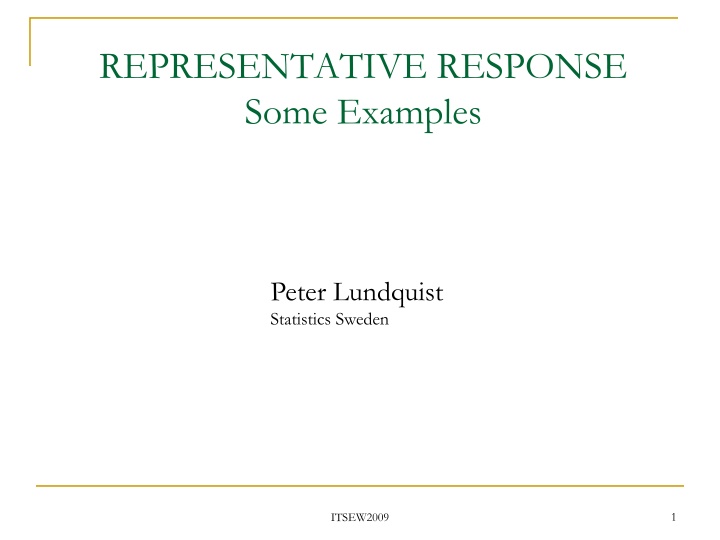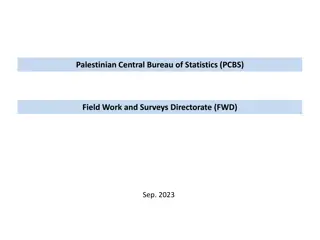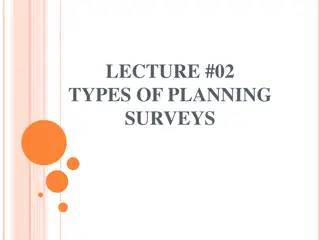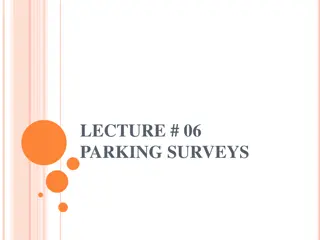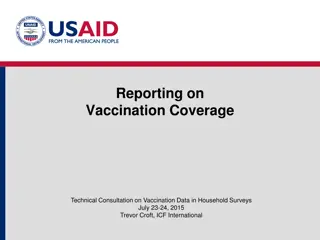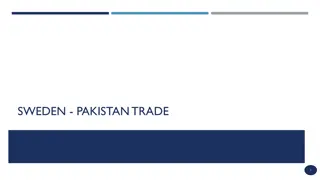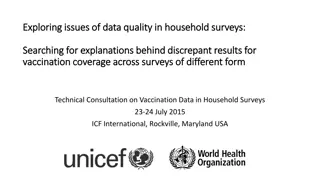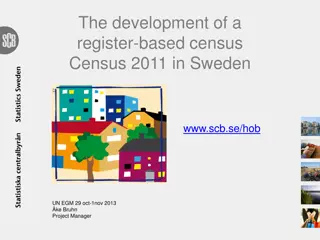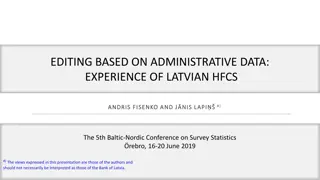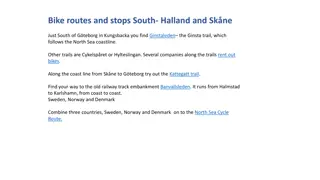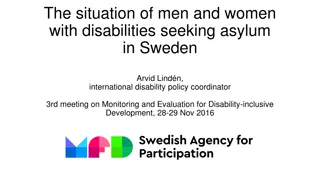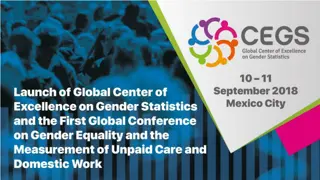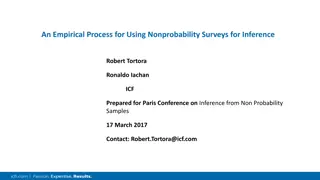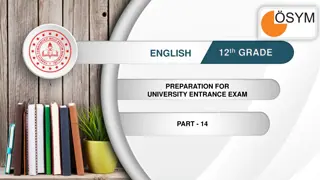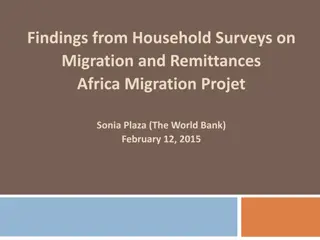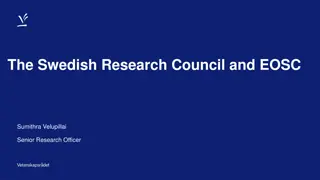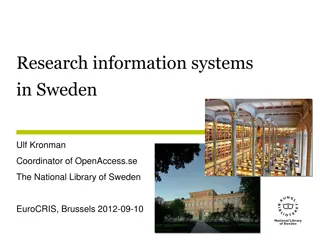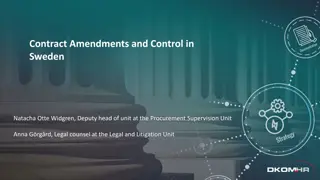Examples of Household Finances and Surveys in Sweden
This content provides a detailed overview of representative responses, household finances data from 2006 and comparative analysis, living condition surveys from 2007, response rates, auxiliary variables, and major reasons for nonresponse. It highlights methodologies, sample sizes, response rates, and key findings from various surveys in Sweden.
Download Presentation

Please find below an Image/Link to download the presentation.
The content on the website is provided AS IS for your information and personal use only. It may not be sold, licensed, or shared on other websites without obtaining consent from the author.If you encounter any issues during the download, it is possible that the publisher has removed the file from their server.
You are allowed to download the files provided on this website for personal or commercial use, subject to the condition that they are used lawfully. All files are the property of their respective owners.
The content on the website is provided AS IS for your information and personal use only. It may not be sold, licensed, or shared on other websites without obtaining consent from the author.
E N D
Presentation Transcript
REPRESENTATIVE RESPONSE Some Examples Peter Lundquist Statistics Sweden 1 ITSEW2009
Household Finances 2006 (HF) Design: Stratified network sample (18 years and older from RTP all household members are included) Sample size: 17013 households Mode: telephone (approx. 1/2 hour interview) Response rate: 69.6% Auxiliary variables are matched from external registers 2
HF: Estimated Mean Income Divided by Consumption Units 195000 95% upper limit Estimate responding units 190000 Estimate sample 95% lower limit 185000 180000 175000 170000 165000 1 2 3 4 5 6 7 8 9 1011121314151617181920 WD-event From Westling (2008) 3
HF: Comparison Between HT and GREG-estimators 60 Employed HT-estimator 50 Employed GREG-estimator 40 Not in labour force GREG-estimator % 30 Not in labour force HT-estimator 20 10 0 1 2 3 4 5 6 7 8 9 10 11 12 13 14 15 16 17 18 19 20 WD-events From Westling (2008) 4
Living Condition Survey 2007 (LCS) Design:srs, 16 years and older from RTP Sample size: 7694 Mode: telephone (approx. 1 hour interview) Response rate: 73.4% Auxiliariy variables are matched from external registers Missing telephone-number for 3.7% of the sample 5
LCS: Response Rate Outcome Rate No. in Sample 5651 % Respondents 73.4 Noncontacts 664 8.6 Refusals 1194 15.5 Other nonresponse 185 2.4 All 7694 100.0 6
LCS: Auxiliary Variables Age Gender Country of Birth Marital Status Employment status Region Social allowance Type of housing estate Income Education Telephone (Sample based) 7
LCS: Major Reasons for Nonresponse Age [Refusal: 35-64 years, Noncont: -34 years, Other:74+ years] Gender Country of Birth [Noncont and Other: born outside Sweden] Marital Status [Noncont: unmarried ] Employment status [Other: unemployed] Region [Noncont: living in big cities] Social allowance [Noncont and Other: if having allowance] Type of housing estate [Noncont: rented housing] Income [Noncont: no income Other: low income] Education [Nocont and Other: education code is missing] Telephone (Sample based) [Noncont: no phone] 8
LCS: Logit Model Response as Dependent Parameter Estimates Before and After Nonresponse Follow-up Resp5w PCT100 Parameter Intercept AGE_24 AGE35_64 AGE65_74 AGE75_ Sw.born Female Employed Married Big City Soc. Allowance Owned housing No income High income No edu. code Low edu. High edu. Telephone Estimate Std. Error sign Estimate Std. Error sign -0.7815 0.7416 -0.0050 0.3254 0.3423 0.1450 0.1962 0.0967 0.2500 -0.1367 -0.3381 0.1383 -0.2147 0.2050 -0.3985 -0.1311 0.3443 0.9154 0.1267 0.1002 0.0760 0.1113 0.1237 0.0730 0.0510 0.0727 0.0571 0.0540 0.1553 0.0587 0.1099 0.0666 0.2310 0.0683 0.0777 0.0829 *** *** *** *** ** *** *** ** ** ** * *** * * *** *** -0.5269 0.8342 -0.0466 0.3102 0.2417 0.1471 0.2488 0.1908 0.2558 -0.2374 -0.2342 0.1633 -0.2527 0.1542 -0.5524 -0.1691 0.3878 1.0337 0.1315 0.1088 0.0813 0.1201 0.1309 0.0771 0.0549 0.0782 0.0615 0.0576 0.1588 0.0634 0.1151 0.0719 0.2353 0.0729 0.0859 0.0837 *** *** *** * * *** ** *** *** *** ** ** ** ** *** *** *) sign. level 10% **) sign. level 5% ***) sign. level 1% 9
LCS: Indicators Based on estimated response probabilities under srs the following R-indicator (Schouten and Cobben 2007, 2008) is used 1 R = 2) 1 2 ( s k 1 n s and under srs the q2-indicator (S rndal and Lundstr m 2008) is m k = = 2 2 1 T T k x x x x q ( / ) where ( ) ( ) s n m m I k k k k m s r 10
LCS: Indicators A measure of the estimated relative bias (in per cent) is computed by y ( ) 100 1 EXP y RB y EXP s As variables ykSickness and activity allowance (yes/no), Income, Sickness pay (yes/no) and Employed (yes/no) are used to estimate the relative bias. All indicators computed for Resp5w and PCT100 11
LCS: R and q2 Indicators for Response Before and After Follow-up ( ) RB y EXP s R 0.78 0.77 2 Iq 0.089 0.062 Response Resp5w Sick allow. Sick pay Employed Income -8.0 1.8 17.2 -0.7 8.0 0.8 3.0 1.2 -6.6 1.6 1.5 -3.6 Refusal Noncont+Other PCT100 -8.5 4.7 50.0 0.7 5.2 3.4 5.2 1.2 6.6 Refusal Noncont+Other -11.6 -30.1 -16.8 12
LCS: Conclusions The representativity doesn t increase with the follow-up The indicators are estimates e.g. they are subject to variation (not computed) The same goes for the relative bias Active work with strategies for the group having social allowance and those with missing telephone Found auxiliary variables could be used in the creation of a new estimator 13
Labour Force Survey (LFS) Data from March-December 2007 Supplemented with: Annual salary 2006 according to the Swedish Tax Register Process data from WinDati (CATI-system) . 14
Response Rates for the Reference Weeks in a LFS Month (Means Based on LFS March-December 2007) 0,9 Response Rate 0,8 0,7 0,6 0,5 Mresp W1 Mresp W2 Mresp W3 0,4 Mresp W4 Mresp W5 0,3 . 0,2 0,1 0 0 5 10 15 20 25 30 35 40 45 50 Field Days 15
Contact Days for the Reference Weeks in a LFS Month (Means Based on LFS March-December 2007) Mean Contact Days 3,5 3 2,5 MV Week1 2 MV Week2 MV Week3 MV Week4 MV Week5 1,5 1 0,5 0 0 5 10 15 20 25 30 35 40 45 50 Field day 16
Total Number Contact Days, Reference Weeks, in a LFS Month (Means Based on LFS March-December 2007) Response Rate 0,900 0,800 0,700 0,600 Mresp W1 0,500 Mresp W2 Mresp W3 Mresp W4 0,400 Mresp W5 0,300 0,200 0,100 0,000 0 2000 4000 6000 8000 10000 12000 14000 Contact Days 17
Relative Bias for Income Accumulated on Contact Days, in a LFS Month (Means Based on LFS March-December 2007) 6 Relative Bias 5 4 3 Rbias Week1 Rbias Week2 Rbias Week3 Rbias Week4 2 Rbias Week5 1 0 0 2 4 6 8 10 12 14 16 Contact Days -1 18
LFS: Final Variability in Relative Bias for Income, Reference Weeks (Means Based on LFS March-December 2007) Number of Observations 10 10 10 10 3 10 Mean Relative Bias in Percent 4.17 3.90 4.22 3.65 4.91 4.08 Low 95-Percent confidence interval 3.75 3.46 3.59 3.00 4.33 3.69 High 95-Percent confidence interval 4.58 4.35 4.84 4.29 5.48 4.46 Week 1 Week 2 Week 3 Week 4 Week 5 All 19
HF 2006, LCS 2007 and LFS 2007: Estimated Relative Bias of mean Income in SEK in Percent and Outcome Rates HF 2006 LCS 2007 LFS 2007 Outcome Rate % Rel. Bias 2.7 % of Sample* 70.3 % Rel. Bias 1.2 % of Sample 73.4 % Rel. Bias 4.1 % of Sample** 81.7 Respondents Refusals 5.1 16.8 6.6 15.5 -1.9 7.8 Noncontacts + Other Nonresp. -19.8 12.9 -16.8 11.0 -32.8 10.5 *) Based on 36,864 individuals **) Based on the average of 10 months LFS (21,500 individual each month) 20
References Cobben, F. and Schouten, B. (2008). An empirical validation of R-indicators. Discussion paper 08006, CBS, Voorburg. Schouten, B. and Cobben, F. (2007). R-indexes for the comparison of different fieldwork strategies and data collection modes. Discussion paper 07002, CBS, Voorburg. S rndal, C.E. and Lundstr m, S. (2008). Assessing auxiliary vectors for control of nonresponse bias in the calibration estimator. Journal of Official Statistics, 24, 167-191. Westling, S. (2008). Utveckling f r system av kontaktstrategier i intervjuunders kningar med individer och hush ll Delrapport II, unpublished report, rebro, Sweden: Statistics Sweden. [In Swedish] 21
